

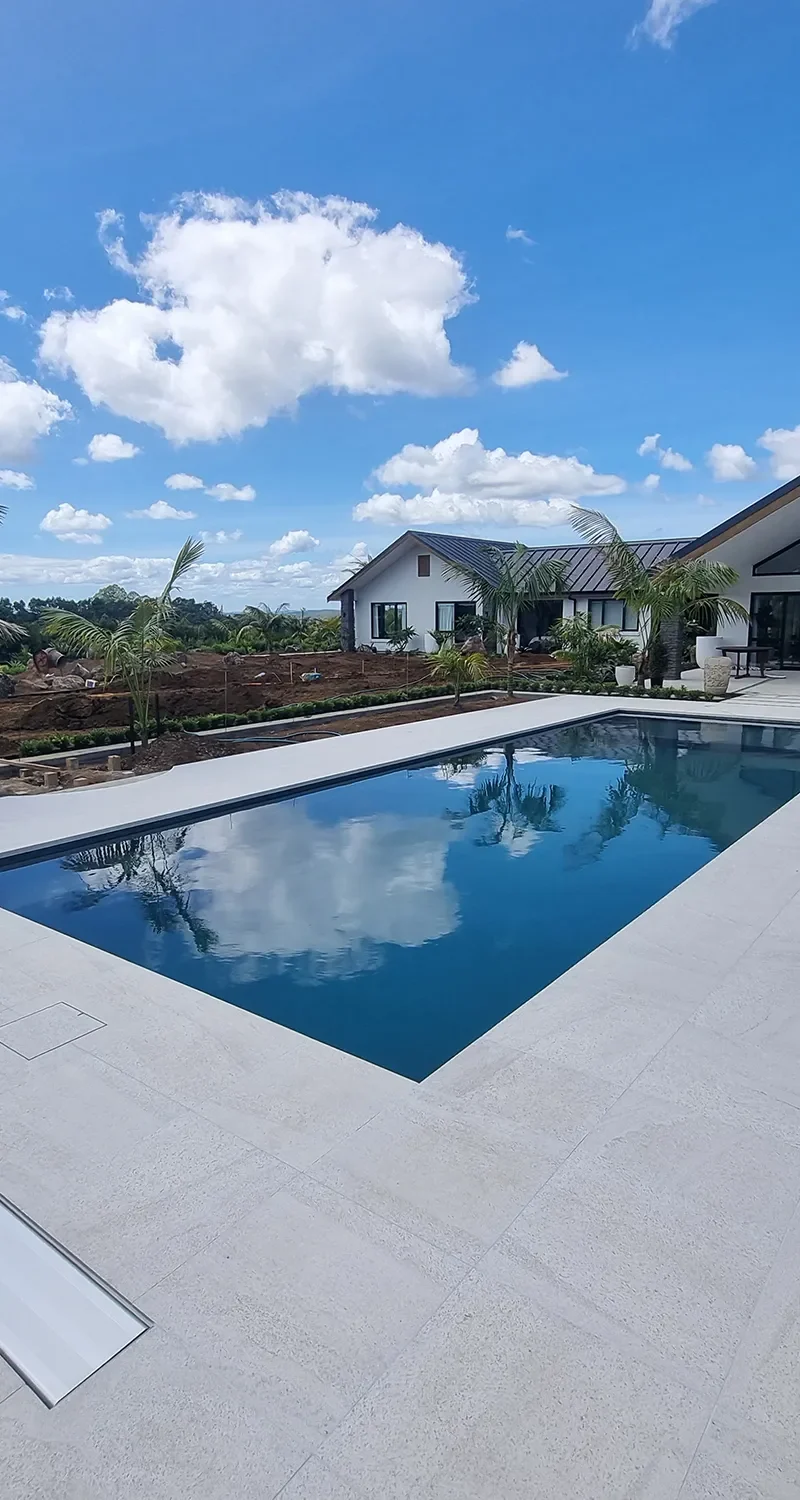
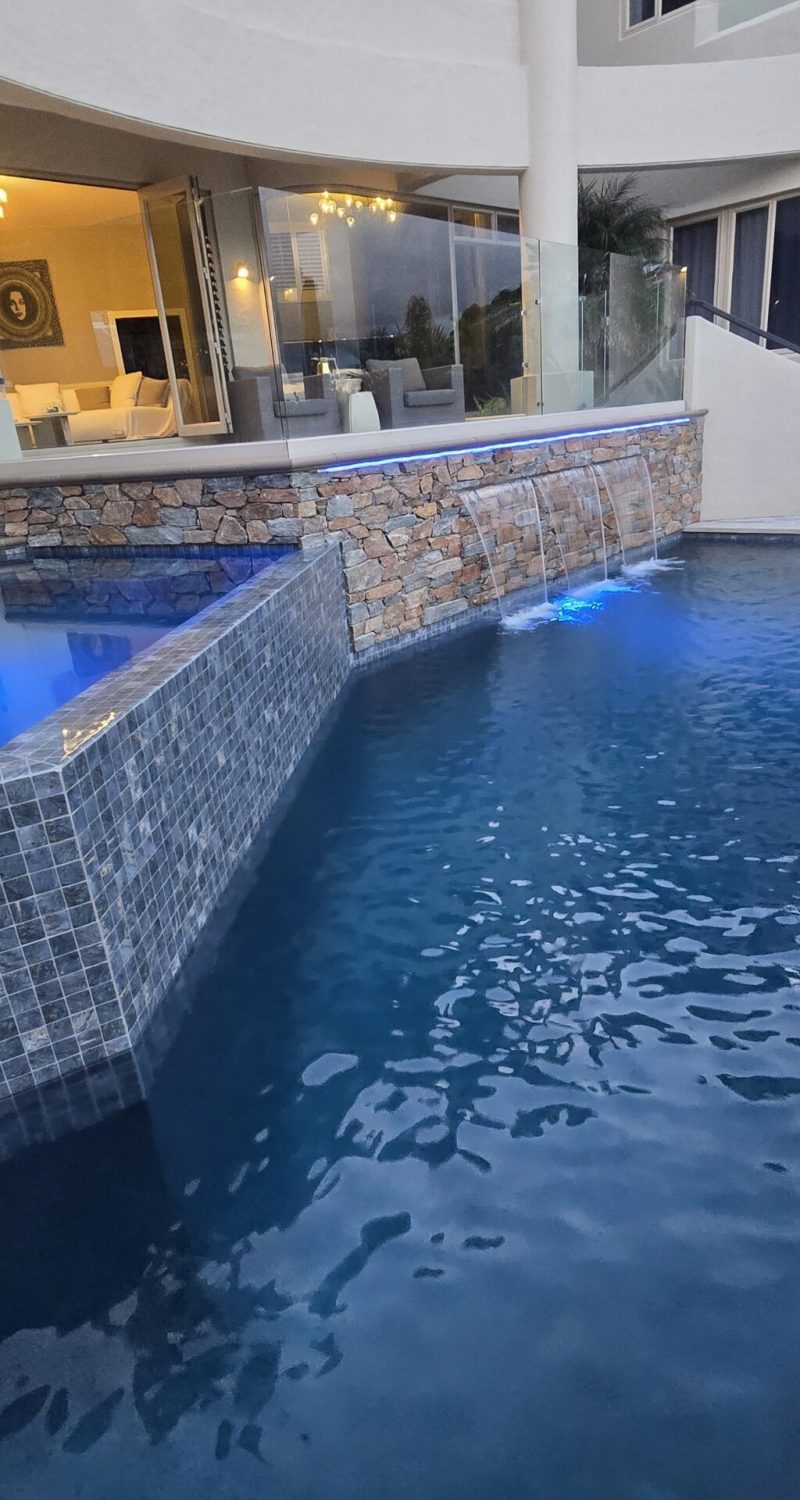
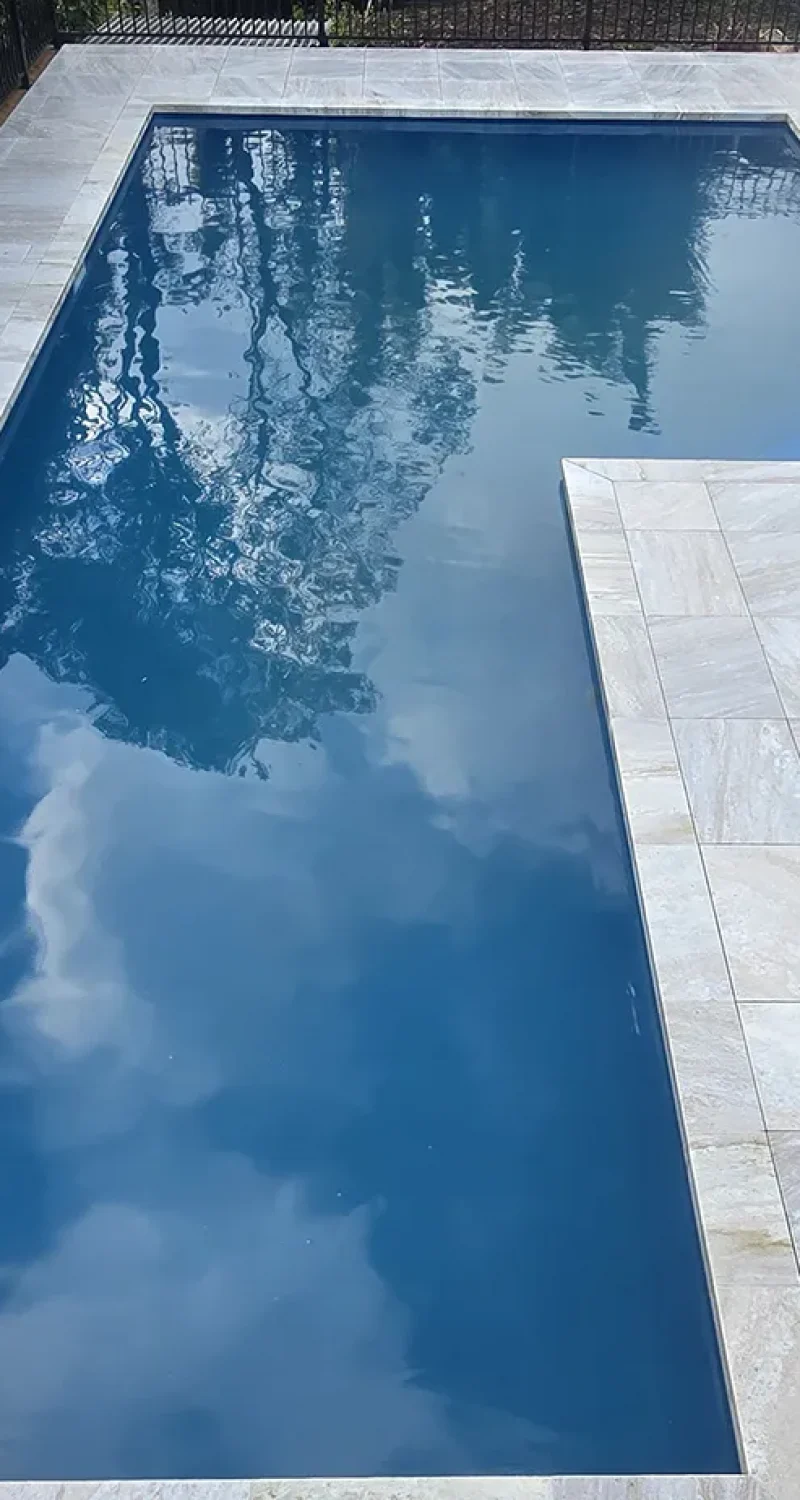
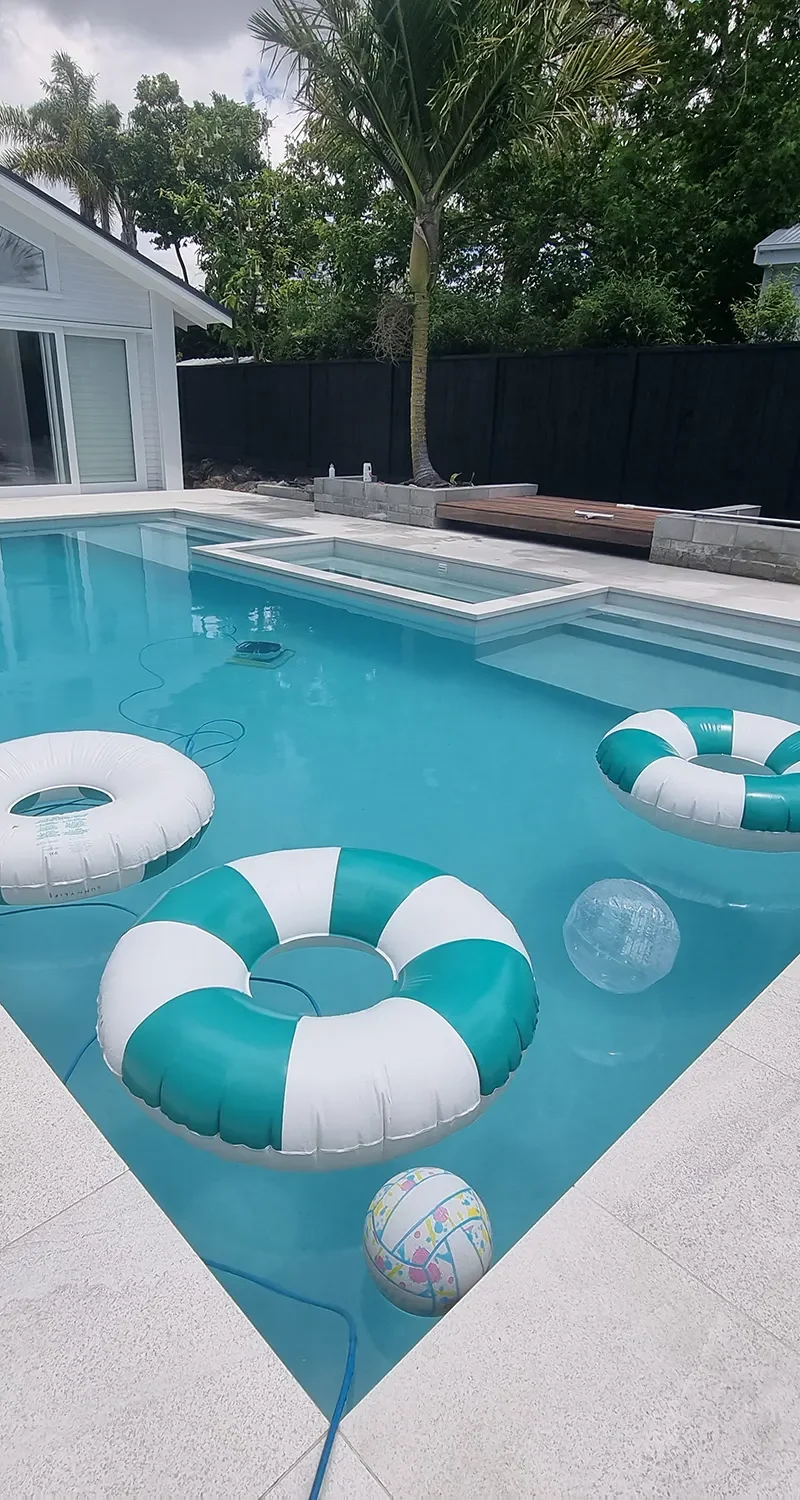
At Artisan Stone & Tile, we understand that starting a pool renovation can come with a lot of questions. From the cost of pool coping to how long resurfacing takes, we’re here to provide clear, honest answers. Our commitment to transparency means you’ll always know what to expect, and our expert team is available to guide you through every step of the process.
Explore our FAQ section for answers to the most common questions about our pool renovation services in Auckland.
Pool coping not only enhances the aesthetic appeal of your pool but also serves as a crucial protective feature, preventing water from seeping behind the pool shell and ensuring safety. Whether you’re upgrading or installing new coping, here’s everything you need to know to make the right choice for your Auckland pool.d

The cost varies based on the material and the size of your pool, but it generally ranges from $30 to $60 per linear foot, including installation.
The most popular pool coping options are bullnose and cantilevered styles. Bullnose provides a rounded edge for safety, while cantilevered coping creates a seamless look with the pool deck.
Installing pool coping typically takes 2-3 days, depending on the size of the pool and the material chosen.
Yes, it is possible to replace pool coping without draining the pool, although care must be taken to avoid contaminating the water during installation.
Pool coping typically hangs over the pool edge by about 1-1.5 inches. This overhang provides a clean edge and helps direct water into the pool.
Yes, concrete pavers are a popular and durable option for pool coping. They are cost-effective and can be replaced individually if damaged.
Pool tiling adds elegance and durability to your pool, making it a long-lasting and visually appealing feature. Here are the answers to some common questions about pool tiling.
Porcelain, mosaic, and glass tiles are the most popular choices due to their durability, water resistance, and variety of designs.
With proper maintenance, pool tiles can last 20 years or more. Regular cleaning and good water chemistry can extend the lifespan.
Yes, you can replace pool tiles without renovation, provided the pool’s surface is in good condition and doesn’t require major repairs.
Certain pool tiles, such as those with a textured finish, are designed to be slip-resistant, making them ideal for pool areas.
Yes, you can tile the entire pool, including the walls and floor. Full tiling offers a luxurious look, though it’s more expensive than partial tiling.
The most affordable way to tile a pool is by using ceramic or porcelain tiles, which offer durability at a lower cost than glass or natural stone tiles.
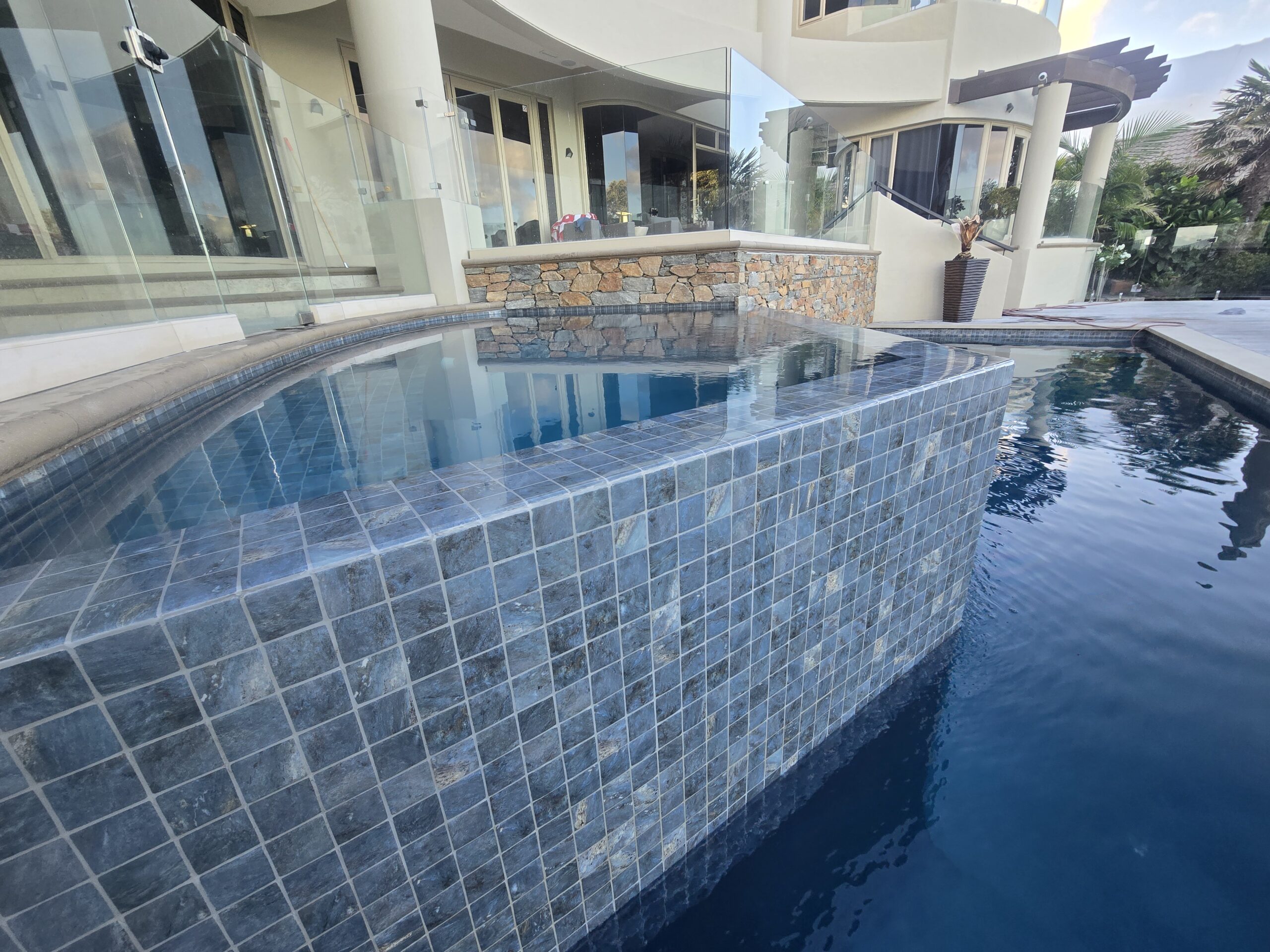
A pool renovation can breathe new life into your outdoor space, but you might have questions about the process, costs, and benefits. Here’s what you need to know about pool renovations.
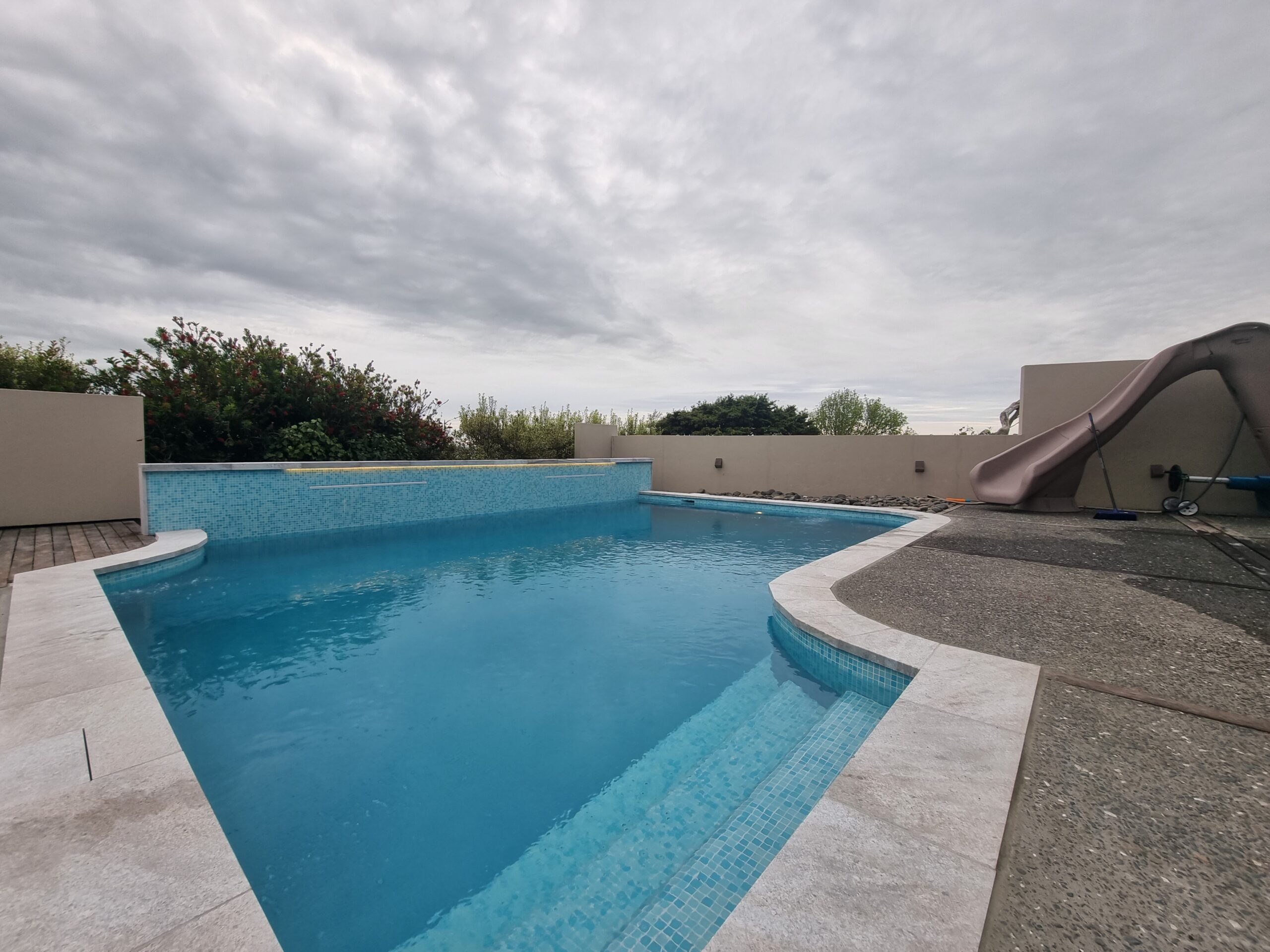
The cost of a pool renovation depends on the scope of the project, including resurfacing, tiling, and coping. Typically, renovations can range from $5,000 to $20,000 depending on the materials and complexity.
A typical pool renovation can take anywhere from 2-6 weeks, depending on the extent of the work. This includes planning, preparation, and installation time.
Pool renovations can include resurfacing, tiling, coping replacements, plumbing updates, and even upgrading features like lighting and heating systems.
Yes, during a renovation, it is possible to change the shape of your pool. However, this significantly increases both the time and cost of the project.
Most renovations, including resurfacing and tiling, require the pool to be drained. However, some minor repairs can be done without draining the entire pool.
Absolutely! During a renovation, you can add new features like LED lighting, waterfalls, or a heating system to enhance the pool’s functionality and aesthetic appeal.
Resurfacing your concrete pool can give it a fresh look while improving its durability. Here are the most common questions homeowners have about concrete pool resurfacing.
The cost typically ranges between $5,000 and $15,000 depending on the size of the pool and the material used for renovation.
The renovation process usually takes 1-2 weeks, depending on the condition of the existing surface and weather conditions.
A properly renovated concrete pool can last anywhere from 10 to 20 years with good maintenance and regular cleaning.
Yes, the pool must be completely drained before renovation can begin to ensure the best results and proper adhesion of the new material.
Common materials used include plaster, pebble, quartz, and polished aggregate, each offering different textures, colors, and durability.
Yes, any cracks or damage to the pool’s surface will be repaired during the renovation process to ensure a smooth, durable finish.

Cladding is a protective layer added to the exterior of a building. It’s not only crucial for enhancing the building’s appearance but also serves as an extra shield against weather, provides insulation, and improves overall durability. The right cladding can even increase property value by enhancing curb appeal.
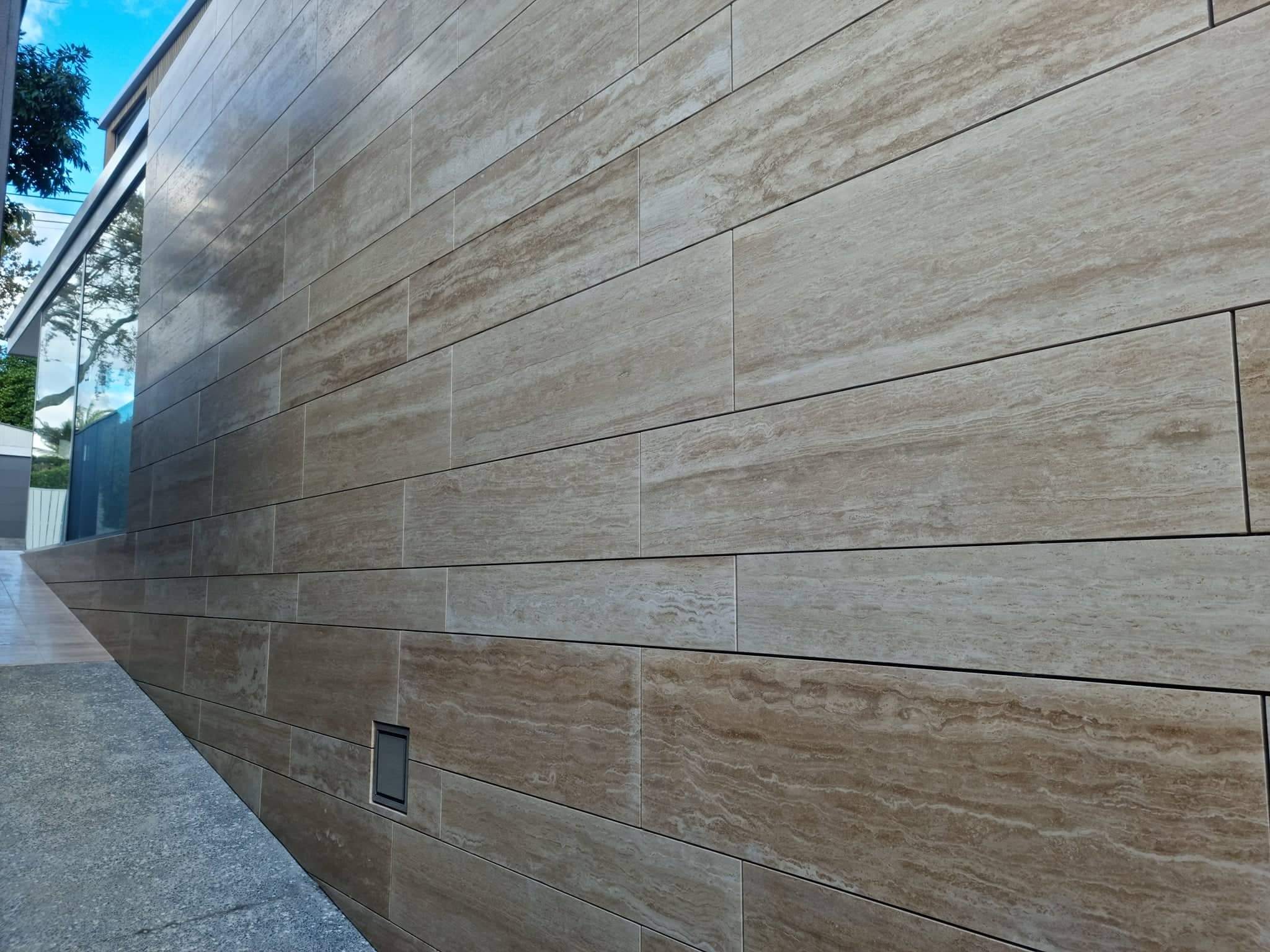
Cladding is a protective layer added to the exterior of a building. It’s not only crucial for enhancing the building’s appearance but also serves as an extra shield against weather, provides insulation, and improves overall durability. The right cladding can even increase property value by enhancing curb appeal.
Cladding comes in a variety of materials, including wood, metal, vinyl, stone, and composite. Each material has its own benefits and considerations. For example, wood offers a natural, warm look but requires more maintenance, while metal is highly durable and low-maintenance but can be pricier.
Yes, cladding can be adapted for most home styles, but the choice of material and design should match the architectural style of the house. Modern homes may look great with sleek metal or composite panels, while traditional homes might suit timber or stone cladding.
Maintenance depends on the material. Timber cladding, for example, needs regular sealing or painting to prevent weather damage, whereas vinyl and metal cladding are generally low-maintenance and only need occasional cleaning. Always check the maintenance requirements before choosing a material.
Yes, quality cladding can significantly improve a home’s energy efficiency by adding an extra layer of insulation. This can help regulate indoor temperatures, reducing the need for heating and cooling and lowering energy bills in the long run.
Installing cladding involves preparing the wall surface, attaching battens for support, and fixing the cladding panels securely. It’s best handled by professionals to ensure a proper fit, effective insulation, and a flawless finish. The installation time varies depending on the material and size of the project.
Tiling around your pool and patio not only enhances the beauty of your outdoor space but also ensures durability and safety for years to come. Here’s what you need to know about choosing the right tiles and maintaining them for your Auckland property.
The cost for tiling varies depending on the material and layout, typically ranging from $90 to $250 per square meter, including installation.
Porcelain and natural stone tiles are popular choices due to their durability, slip resistance, and aesthetic appeal. Both options provide long-lasting performance even in wet conditions.
Yes, you can use the same tiles for both areas. Many homeowners prefer a seamless design by using the same tile, but you can also choose complementary tiles for a unique look.
Tiling both a pool and patio typically takes 2 to 3 weeks, depending on the size of the area and the complexity of the design.
Pool tiles are specifically designed to withstand constant exposure to water, chemicals, and varying temperatures, making them more durable than standard patio tiles.
Regular cleaning with mild soap and water will keep the tiles looking fresh. For natural stone tiles, periodic sealing may be necessary to maintain their appearance and longevity.
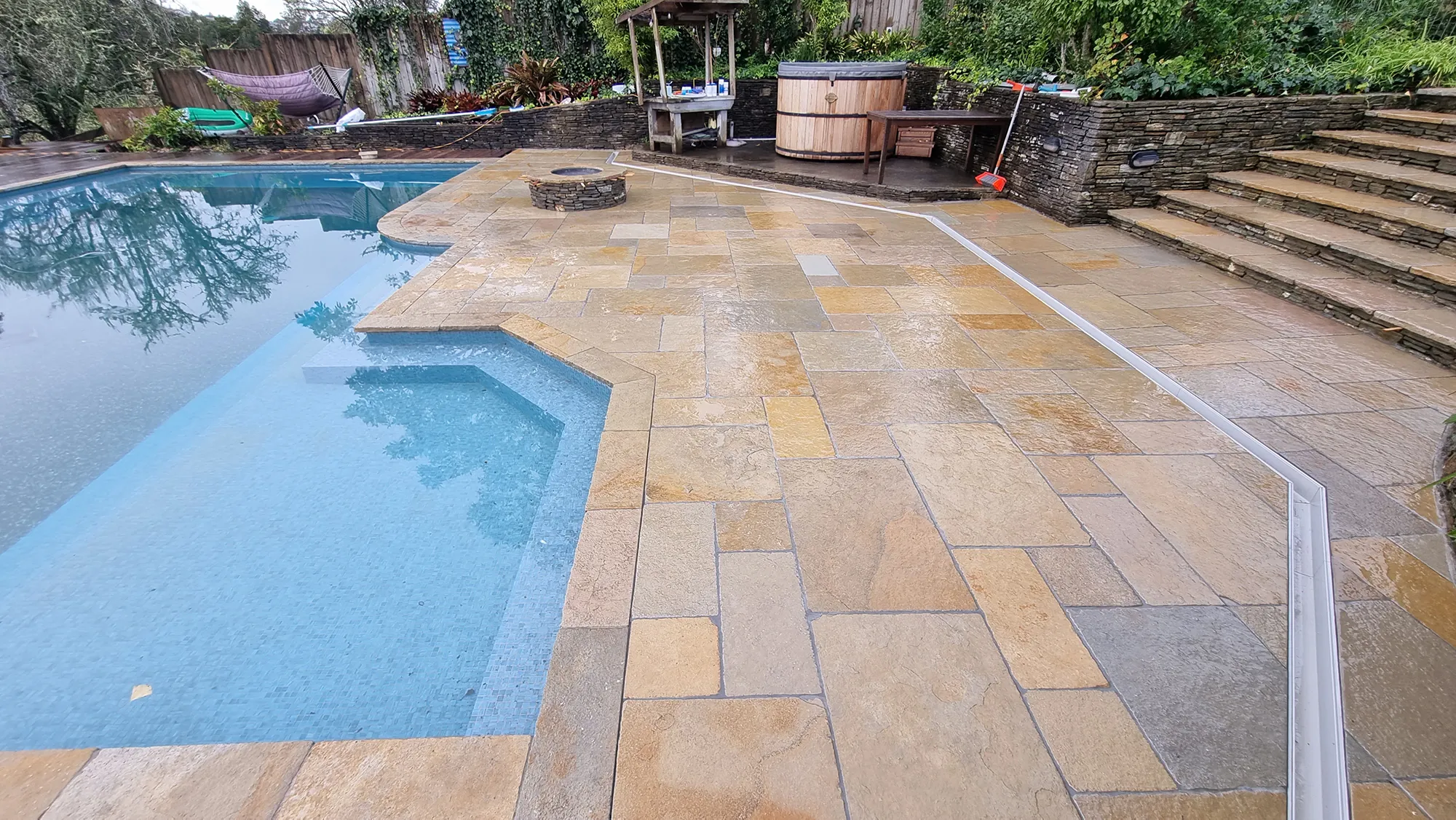
artisan stone and tile, chevron cladding
When considering a pool renovation, understanding the associated costs is crucial for budgeting. The overall price can vary significantly based on the scope of work, materials chosen, and the complexity of the project. On average, homeowners can expect to pay between $5,000 and $20,000, which encompasses everything from resurfacing and tiling to coping and additional features.
For a more accurate estimate, it’s advisable to consult with a professional who can assess your specific needs and provide a detailed quote. Factors such as the size of the pool, the type of materials selected, and the labor involved will all influence the final cost. Additionally, unexpected repairs may arise, so it's wise to allocate a contingency budget to cover such scenarios.
Selecting the appropriate materials for your pool renovation is essential for both aesthetics and durability. Common options include plaster, pebble, quartz, and various types of tiles, each offering unique benefits. For example, glass tiles provide a modern look and are highly resistant to fading, while plaster offers a classic finish but may require more maintenance over time.
When making your selection, consider factors such as slip resistance, maintenance requirements, and how well the materials will withstand harsh weather conditions. Consulting with professionals can also help you understand the long-term implications of your choices, ensuring that your pool not only looks great but also lasts for years to come.
Opting for professional pool renovation services can significantly enhance the quality and efficiency of the renovation process. Experts bring a wealth of knowledge and experience, ensuring that every aspect of the project is handled with precision. From initial design to final installation, professionals can help you avoid common pitfalls that may arise during DIY renovations.
Moreover, hiring professionals often means access to better materials and techniques that may not be available to the average homeowner. This can lead to improved durability and aesthetics, ultimately adding value to your property. Additionally, professional services typically include warranties, providing peace of mind that your investment is protected.
Once your pool renovation is complete, proper maintenance is crucial to keep it looking and functioning at its best. Regular cleaning, water testing, and timely repairs can prevent minor issues from escalating into costly repairs. Establishing a maintenance schedule can help ensure that your pool remains a safe and inviting space for family and friends.
In addition to routine upkeep, consider seasonal tasks such as winterizing your pool or preparing it for summer use. This includes checking for any wear and tear, balancing chemicals, and inspecting the pool's features. By staying proactive about maintenance, you can enjoy your renovated pool for many years to come.
artisan stone and tile, chevron cladding
When considering a pool renovation, understanding the associated costs is crucial for budgeting. The overall price can vary significantly based on the scope of work, materials chosen, and the complexity of the project. On average, homeowners can expect to pay between $5,000 and $20,000, which encompasses everything from resurfacing and tiling to coping and additional features.
For a more accurate estimate, it’s advisable to consult with a professional who can assess your specific needs and provide a detailed quote. Factors such as the size of the pool, the type of materials selected, and the labor involved will all influence the final cost. Additionally, unexpected repairs may arise, so it's wise to allocate a contingency budget to cover such scenarios.
Selecting the appropriate materials for your pool renovation is essential for both aesthetics and durability. Common options include plaster, pebble, quartz, and various types of tiles, each offering unique benefits. For example, glass tiles provide a modern look and are highly resistant to fading, while plaster offers a classic finish but may require more maintenance over time.
When making your selection, consider factors such as slip resistance, maintenance requirements, and how well the materials will withstand harsh weather conditions. Consulting with professionals can also help you understand the long-term implications of your choices, ensuring that your pool not only looks great but also lasts for years to come.
Opting for professional pool renovation services can significantly enhance the quality and efficiency of the renovation process. Experts bring a wealth of knowledge and experience, ensuring that every aspect of the project is handled with precision. From initial design to final installation, professionals can help you avoid common pitfalls that may arise during DIY renovations.
Moreover, hiring professionals often means access to better materials and techniques that may not be available to the average homeowner. This can lead to improved durability and aesthetics, ultimately adding value to your property. Additionally, professional services typically include warranties, providing peace of mind that your investment is protected.
Once your pool renovation is complete, proper maintenance is crucial to keep it looking and functioning at its best. Regular cleaning, water testing, and timely repairs can prevent minor issues from escalating into costly repairs. Establishing a maintenance schedule can help ensure that your pool remains a safe and inviting space for family and friends.
In addition to routine upkeep, consider seasonal tasks such as winterizing your pool or preparing it for summer use. This includes checking for any wear and tear, balancing chemicals, and inspecting the pool's features. By staying proactive about maintenance, you can enjoy your renovated pool for many years to come.